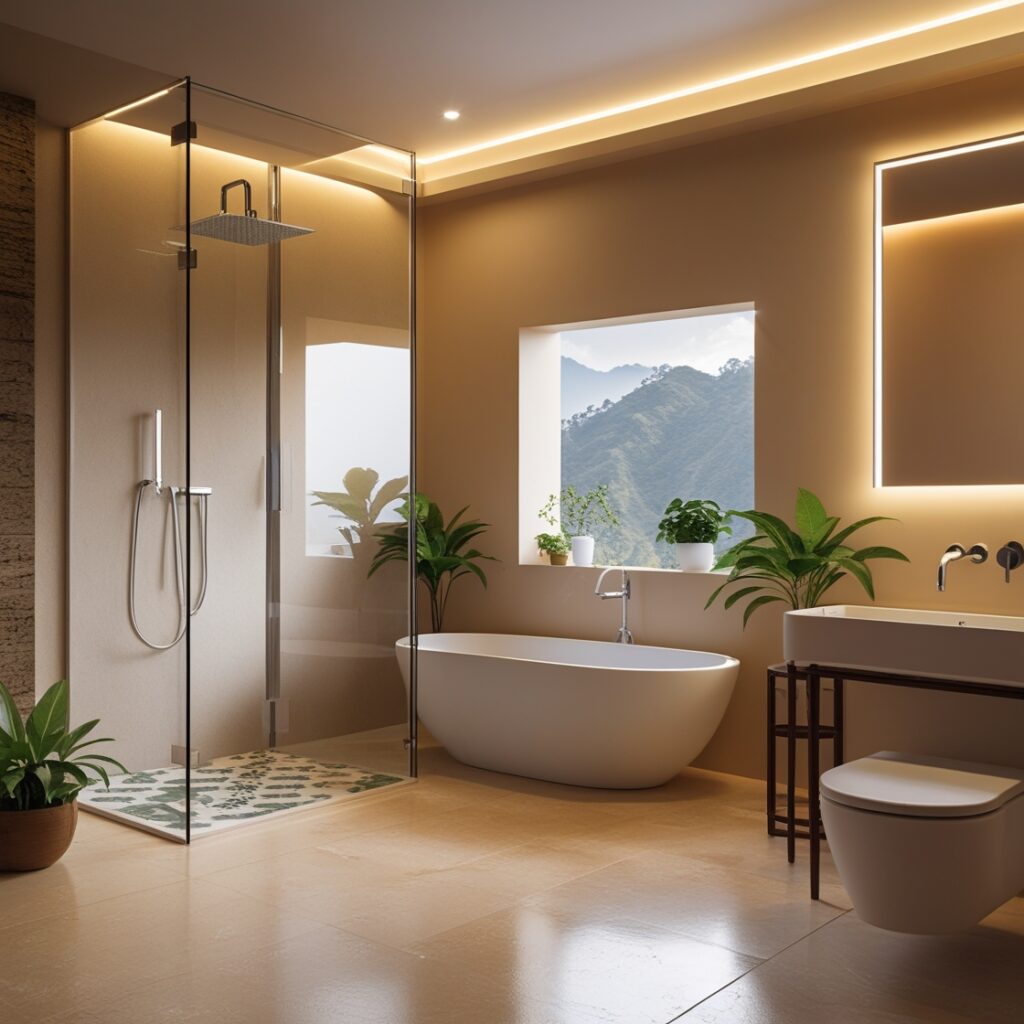In Nepal, the bathroom is evolving beyond a purely functional space into a sanctuary of relaxation, self-care, and artistic expression. As urbanization accelerates and global design trends merge with local traditions, Nepali homeowners are reimagining bathrooms as holistic retreats that balance sustainability, cultural identity, and cutting-edge innovation. Let’s explore the key trends shaping bathroom design in Nepal today.
1. Embracing Nature: Warmth and Organic Materials
The 2025 bathroom aesthetic leans heavily on natural elements, creating spaces that feel grounded and serene. Warm, earthy tones like terracotta, sand, and muted greens dominate color palettes, replacing stark whites and clinical finishes. These hues evoke Nepal’s rugged landscapes and foster a calming atmosphere .
Natural materials such as wood, stone, and bamboo are central to this trend. Reclaimed wood vanities, stone basins, and bamboo accessories bring tactile warmth while aligning with Nepal’s growing emphasis on sustainability . For instance, wooden carvings inspired by traditional Newari architecture are being reinterpreted in modern vanity units, blending heritage with contemporary minimalism .
2. Smart Technology for Enhanced Comfort
Nepal’s urban households are adopting smart bathroom technologies to elevate convenience and hygiene. Voice-activated showers, sensor taps, and app-controlled lighting systems are becoming staples in Kathmandu and Pokhara. For example, Jaquar’s smart showers allow users to preset water temperature and flow via smartphone, merging luxury with efficiency .
AI-powered innovations are also making waves. The BMind Smart Mirror, equipped with mood-detecting AI, offers personalized wellness routines like guided meditations—perfect for stress relief in fast-paced cities . Touchless fixtures, such as TOTO’s WASHLET G5A toilet, prioritize hygiene while reducing water waste, a critical feature in water-scarce regions .
3. Sustainability: Eco-Conscious Choices
Nepali designers are prioritizing eco-friendly solutions, from water-saving fixtures to locally sourced materials. Low-flow showerheads and energy-efficient heating systems reduce utility costs without compromising performance, aligning with global sustainability goals . Brands like Kohler and Jaquar emphasize recycled materials and carbon-neutral manufacturing, resonating with Nepal’s environmentally conscious middle class .
The trend extends to decor: indoor plants like snake plants and pothos purify air while adding biophilic charm, and reclaimed terracotta tiles echo traditional Nepali craftsmanship .
4. Fusion of Modern and Traditional Design
A hallmark of Nepali interior design is the seamless blend of global trends with cultural heritage. In bathrooms, this manifests through:
- Dhaka fabric accents: Vibrant patterns adorning shower curtains or towels.
- Thangka art: Spiritual paintings displayed as focal points on minimalist walls.
- Carved wooden elements: Intricate window frames or mirrors inspired by temple architecture .
Even open-plan layouts, which merge bathrooms with bedrooms, incorporate traditional materials like handwoven rugs or stone flooring to maintain cultural continuity .
5. Wellness-Driven Spaces
Wellness is at the heart of 2025 bathroom design. Hydrotherapy showers with massage jets and ambient LED lighting transform daily routines into spa-like experiences. Kohler’s freestanding tubs, sculpted with organic curves, invite relaxation, while aromatherapy diffusers infuse spaces with calming scents like lemongrass and sandalwood .
For smaller urban bathrooms, frameless glass enclosures and mirrored walls create an illusion of space, enhancing mental clarity. Integrated seating and built-in storage ensure clutter-free zones, promoting a tranquil environment .
6. Bold Statements with Texture and Lighting
Texture plays a pivotal role in adding depth. Designers juxtapose glossy marble with rough-hewn stone or pair matte black fixtures with brushed brass accents for contrast . Wall-to-wall tiles in geometric patterns or 3D textures infuse personality, especially in compact spaces .
Lighting is equally transformative. Layered setups—dimmable sconces, under-cabinet LEDs, and pendant lights—allow users to adjust ambiance from invigorating mornings to soothing evenings .
FAQs: Bathroom Design in Nepal
- How can I make a small bathroom feel larger?
- Use light colors, large mirrors, and frameless glass showers .
- What are affordable ways to add luxury?
- Invest in statement lighting, textured tiles, or a freestanding basin .
- Which brands offer sustainable options?
- Kohler, Jaquar, and LAUFEN prioritize eco-friendly materials and water-saving tech .
Conclusion
Nepal’s bathroom design landscape is a testament to the country’s ability to harmonize tradition with innovation. Whether through smart technology, sustainable practices, or cultural motifs, these spaces are becoming personal retreats that reflect both individuality and Nepal’s rich heritage. As homeowners continue to prioritize wellness and environmental responsibility, the bathroom’s role as a sanctuary will only grow more profound.
Explore Kohler Nepal and Jaquar’s latest collections to bring these trends to life. For personalized design advice, consult local experts who specialize in blending global aesthetics with Nepali craftsmanship.


